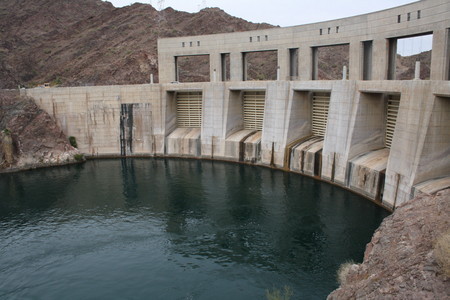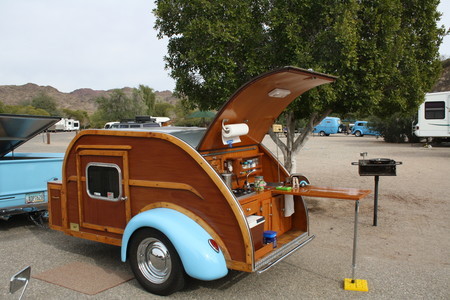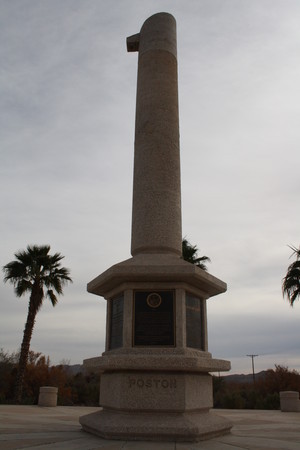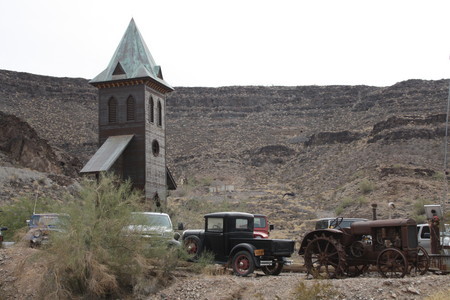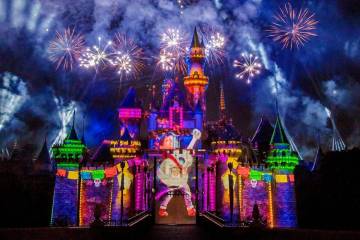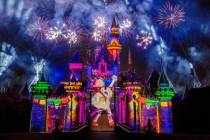Try Parker for a Winter Weekend
Located on "Arizona's West Coast" -- the eastern bank of the lower Colorado River -- the Parker area draws boaters, fisherman, hikers, campers, birders, back road enthusiasts and many others just looking for a scenic drive or a laid-back experience.
I set out to explore those parts earlier this month, accompanied by two of my daughters. We started our visit at the Parker Dam, built between 1934 and 1938 by the Bureau of Reclamation. This one might not look very imposing compared to Hoover and Glen Canyon dams, wedged into deep canyons of the same river, but it's an engineering marvel just the same. While its sister dams are tall, Glen Canyon is the deepest in the world; most of the 320-foot height had to be buried in the riverbed to establish a foundation on bedrock, and only about one-quarter is visible.
Upstream, the dam created Lake Havasu, about 45 miles long and able to store more than 200 billion gallons of water. The dam operates along with Hoover and Davis dams primarily to store water, produce electric power and control flooding along the river, but it also created excellent recreational opportunities for boaters, fishermen and outdoor lovers in general.
Downstream of Parker Dam and running about 16 miles is the "Parker Strip," the name used for the narrow Lake Moovalya created by Headgate Dam. This corridor is extremely popular with boaters and fishermen. We stopped at a few places along here, including the easily accessed Buckskin State Park. The 1,677-acre park is located directly on an exceptionally scenic section of waterway. The park offers all the amenities for those seeking a great weekend or longer car camping trip, including a beach, boat launch area, cabanas, picnic area, hiking trails, restaurant and market.
During our visit, we found a gathering of people who own teardrop trailers, both vintage and new. Teardrop travel trailers were named for their shape. They typically have a sleeping cabin just big enough for two and a galley located under a lift hatch at the rear of the trailer so the cook can stand on the ground while preparing a meal. But their exceptionally compact features allowed them to be streamlined and light enough to pull with almost any auto, so they were popular from the 1940s to the 1960s. There were other classic trailers, including many of the teardrops' somewhat bigger relatives from the same era, often called the "canned ham" style.
The community of Parker is only about one square mile carved from more than 260,000 acres of the Colorado River Indian Reservation. The reservation is primarily in Arizona, but extends four and a half miles into California. Parker serves as the main business center for the surrounding rural areas. The reservation was established by Congress in 1865 for the "Indians of said river and its tributaries." For centuries, this area was home to the Mohave, who were followed by the Chemeheuvi, Hopi and Navajo; all four peoples now share the reservation.
In the forefront of Parker's water scene is the BlueWater Resort and Casino, which opened 10 years ago and is a gaming enterprise of the Colorado River Indian tribes. This is the place to stay if you want easy access to the Colorado River, and all 200 rooms and suites have river views. There is also a three-story indoor water park with two swimming pools, water slide, hot tub and spa. Outdoors is a marina with 164 boat slips.
Our next destination lay just south of Parker, along Mohave Road, where ee found a picturesque section of farm lands. Agriculture is an important economic mainstay here, with close to 85,000 acres planted in a multitude of crops, including cotton, alfalfa, lettuce and wheat.
Besides seeing the peaceful farmlands, we had come to visit the Poston Memorial Monument. During World War II, more than 100,000 people of Japanese ancestry were interned at various camps around the United States, a result of wartime hysteria and racial prejudice. The Poston Relocation Camp was the largest of all, housing close to 18,000 people, most of them American citizens, from 1942-1945.
Although much of the camp is long gone, a stone monument was dedicated in 1992 to mark this dark aspect of our country's history. Its base is shaped like a traditional type of Japanese lantern, with a 30-foot tower rising above. An interpretive kiosk tells about the history of the camp, its residents and the relationship with the people of the Colorado River area.
We had all worked up an appetite, but when I told the girls we were heading about five miles up a rough gravel road to an old mining camp to eat, they rolled their eyes. Off we went, far off the beaten path into the Buckskin Mountains just east of town. The Nellie E. Saloon took its name from the old mining claim where it is built and is also known as the Desert Bar. By either name, I had been told, it was not to be missed.
Part of the fun was getting there. We had a rough set of directions with mileage and such, but my odometer wasn't working and there were no signs. We only passed one car, so we presumed we had taken a wrong turn and were lost, or maybe the place had closed, so we were amazed to suddenly come upon a parking lot with more than 50 vehicles and a milling crowd of people.
Most of those who made it out here were part of a large group of four-wheelers. These casually dressed folks were augmented by a smattering of more dressed-up city folk and families with children.
The bar itself is a small enclosed building with just a few tables, but the main dining area and grill are outdoors, although mostly covered, with other smaller seating areas tucked here and there around various structures the owners have built nearby.
The menu is simple, serving only hamburgers, veggie burgers, hot dogs and chili. Don't even think about ordering cheese, as they boast on their dry erase board menu.... "No cheese EVER." Although the burgers started off frozen, they tasted especially good and at only three bucks a pop, quite cost-friendly. The mood was light and upbeat, and with the hundred or so people, it created a fun atmosphere, only improved by the live band playing, a regular staple here.
We ended our visit with a stop at the 6,105 acres Bill Williams National Wildlife Refuge. Established in 1941, the refuge was named after the mountain man, trapper and guide who traveled throughout much of the West in the 1830s and '40s. Although some of the refuge includes open water on the Colorado River, we took a remote gravel road south and found one of the few remaining natural cottonwood and willow forests on the lower Colorado River. These thick riparian areas once were common along the entire Colorado but sadly, once dams were built, much of this habitat was drowned.
Tucked into the riparian landscape, we found a few saguaro cactus, usually identified with drier lands. The refuge is home to a variety of wildlife including gray fox, javelina, mule deer and desert bighorn sheep. If you are a birder, you will find diversity at the refuge with more than 300 bird species, including many colorful ones such as Lazuli bunting, yellow-billed cuckoo and vermilion flycatchers. The endangered southwestern willow flycatcher nests in the willow trees, and Yuma clapper rails love the marsh areas and sometimes winter here.
We turned homeward then, satisfied with our visit in a single day. But many stay longer. The Parker area is winter territory of the North American motorized snowbird. Formerly most agreeable to those carrying beds in their travel trailers or tents and sleeping bags in their car trunks, the acquisition of a modern resort has made Parker viable for the camping-averse. It's close enough for Las Vegans to visit with little preparation, yet offers a rejuvenating weekend adventure in an agreeable climate, without undue impact upon the wallet.
Contact Deborah Wall at deborabus@aol.com.



